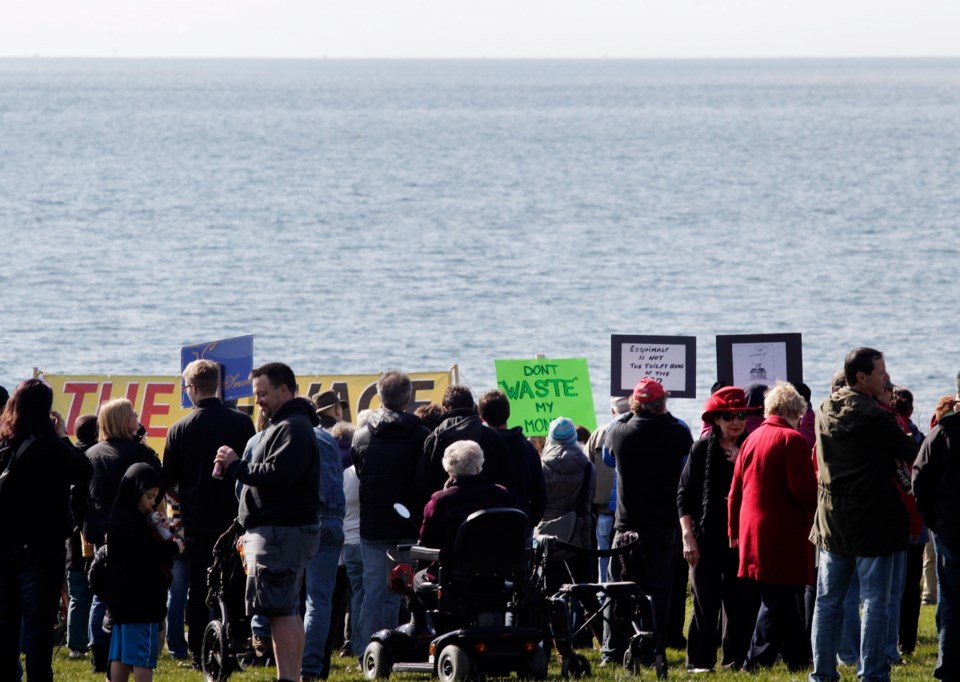Millions of dollars in federal cash are at risk as local politicians scramble to reinvent Greater Victoria’s stalled sewage treatment program.
“The pressure is on and the urgency is there for us to get a resolution,” Capital Regional District chairman Nils Jensen said.
The project has a budget of $788 million. The federal government has committed $253 million coming out of three pots: $120 million from the Building Canada Fund toward the treatment plant; $50 million from the Canada Green Fund for pipes, pump stations and tanks, and $83.4 million from PPP Canada for a biosolids plant.
Building Canada and Canada Green Fund grants carry 2019 project completion deadlines. PPP Canada funding calls for work on the plant to begin between fall 2014 and fall 2017, and be operational by March 31, 2018.
CRD staff have asked for an extension. The feds have offered to push the deadline back a year, but only if the CRD meets certain conditions, including committing to a timeline and project scope and having all approvals in place by March 31, 2016.
“In the event that CRD cannot identify and obtain necessary approvals for the site locations associated with wastewater treatment on or before March 31, 2016, PPP Canada will unfortunately need to reconsider the funding associated with the project,” says a recent letter to the CRD from PPP Canada.
CRD directors essentially have a year to determine where a treatment plant or plants will be built, and have zoning and other approvals in place, or $83.4 million could be gone, Jensen said.
It is unclear what impact loss of federal funding for biosolids would have on the $62 million in provincial funding earmarked for the biosolids plant, Jensen said. “So we’re jeopardizing anywhere from $83 million to $145 million on that plant alone,” he said. The province has committed a total of $248 million.
All federal funding is tied to the Seaterra wastewater treatment program, which would have seen a regional treatment plant at Esquimalt’s McLoughlin Point in operation by 2018. But last year, Esquimalt refused to rezone McLoughlin to permit the plant, and the province refused to override the decision.
Changing the plant location could have a significant impact on federal grants, Jensen said.
“These fundings weren’t available for concepts. In other words, you couldn’t just say we’d like to do some sewage treatment, how about some money? The way these pots work is you had to be specific. You had to be specific about location and you had to be specific about the scope and you had to be specific about the timing,” Jensen said. “That means if we were to change one of those three parameters, it could be deemed to be a significant change.” The CRD might have to reapply “and get back into line” for funds, Jensen said.
The Green Canada fund no longer exists, he said. “There is no line with that pot. So if we are deemed to have made a significant alteration, we would no longer qualify for that and that’s the end of that program.”
Saanich Mayor Richard Atwell told CRD directors this week that the federal government remains committed to funding sewage treatment regardless of scope change. He quoted an August letter from federal Infrastructure, Communities and Intergovernmental Affairs Minister Denis Lebel to Langford Mayor Stew Young in which Lebel says proposed changes, such as plant location, would have to be reviewed but that the federal government remains committed to providing “significant funding.”
“I do believe we have a duty to take care of the funding deadlines and keep those in mind, but . . . that is a significant commitment from the federal government to provide those [funding] pots we were looking at earlier,” Atwell said.
Jensen said the federal government might “remain committed” but a significant change could mean the CRD has to reapply. Further, he said, the letter was written in August. “It’s a very different political and financial reality that we have facing us right now.”
Since McLoughlin was rejected, Esquimalt, View Royal, Colwood, Langford and the Songhees First Nation have formed a committee to explore alternatives. Saanich, Victoria and Oak Bay have done the same.



